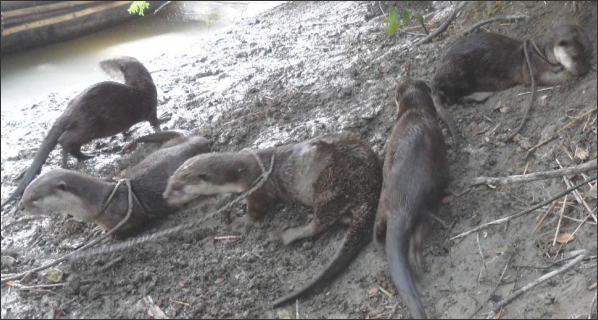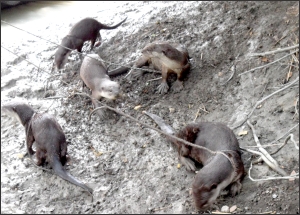Feature
Narail
Otters in Peril
Using otters to catch fish is an age old practice. At Goalbari village in Bangladesh fishermen adore their pet otters, and utilize their amazing skills of driving fishes towards fishing nets. The practice of using these loyal mammals to catch fish is decaying due to the lack to fishes and dried water bodies in Narail.
.................................................................................................
Ponuel S Bose

Pet otters ready go for fishing
Aroti Rani Biswas, housewife of a fisherman of Goalbari village under Narail Sadar upazila treats her pet otter like a part of her family. It gets food even if her family has little to eat. She even feeds the pet otter cow milk. These otters play an important role in the family by helping fishermen catching fish.
Like Aroti, almost all fishermen of Goalbari village, also known as Malopara, feed their domestic dear pet otter is like their children. As a result, an otter serves its master by driving different species of fishes to the fishing net. Fishes like; Salmon, Carp, Koi, Rue, Butter-fish, Trout, Flat-fish, Lata-fish, Sheat-fish, Bata-fish, Tangra and Puti etc.
Goalbari is a village of Korola union, situated by the bank of Gobra tributary of the river Chitra. It is 12 kilometers away to the south from Narail district headquarters. More than one hundred fishing families live there. Most of the families live on fishing from lakes, ponds, wetlands, rivers and water-bodies. The women weave the fishing nets and mend the torn nets, helped by their children.
 Otter is a carnivorous amphibious mammal that feed on fish and shellfish, and also other invertebrates, amphibians, birds and small mammals. They are locally known as 'Dhere'. With an unparalleled skill in fishing, they can dive in deep waters either in the river or in the sea. From the ancient times otters have been domesticated by fishermen. Two men draw the boat – they catch hold of nets carefully while at the same time the otters tied to ropes are released in the water. The otters drive the fishes towards the open net. Surprisingly, often the otters dive into water and catch big fishes and hand over it over to their masters. Otter is a carnivorous amphibious mammal that feed on fish and shellfish, and also other invertebrates, amphibians, birds and small mammals. They are locally known as 'Dhere'. With an unparalleled skill in fishing, they can dive in deep waters either in the river or in the sea. From the ancient times otters have been domesticated by fishermen. Two men draw the boat – they catch hold of nets carefully while at the same time the otters tied to ropes are released in the water. The otters drive the fishes towards the open net. Surprisingly, often the otters dive into water and catch big fishes and hand over it over to their masters.
Borun Kumar Biswas, associate professor of zoology at Narail Government Victoria College, said that due to climate change the otter is now on the verge of extinction. Garbage is thrown in to the rivers causing the rivers to be shallow, and causing pollution – these effects our environment, thus different species of fishes are decreasing from the rivers, water-bodies and marshy lands of the regions. As a result, many fishermen are becoming jobless, and it is becoming increasingly hard to maintain their families as well as their pet otters. He added that fishes and frogs are otters' primary diet that are also decaying form our rivers. Although the villagers live in extreme poverty, they are adamant to save this creature that is vital to their livelihood.
The practice of domesticating and fishing with otters is an old one. The fishermen could not tell when this practice began – it is certain that it is handed down from generation to generation. Otters are part of their lives and are treated as assets to the families.
There were several hundreds of otters in the village even a decade ago. Now, there are only thirty left in Goalbari village. The widespread use of deep-water fishing net led many fishermen to sell their otters, and slowly the practice is decaying.
The otter subfamily Lutrinae forms part of the family Mustelidae, which also includes weasels, polecats, badgers, and wolverines. An otter looks like mongoose and an adult one can grow two feet to three feet in length.
A female otter gives birth at a time four to five pups a year. Pet otter pups suckle its mother milk and cow milk. A six month old otter can hunt fishes with their mothers into waters, and is able to hunt their own.
 Asok Biswas of Bamonkhali village under Magura district came to Goalbari to purchase Otter. He said “I already have one and now I need another. Each costs 10,000 taka. Asok Biswas of Bamonkhali village under Magura district came to Goalbari to purchase Otter. He said “I already have one and now I need another. Each costs 10,000 taka.
Aged fishermen, Rabin Biswas said “we still continue fishing using otters that we learned from our forefathers. The otters we own are affectionate to us like our children – we love them like our own children too. But due to lack of fishes in the rivers and canals, we are facing serious crisis maintaining our family as well as to feeding our otters.
Tusher Biswas, another fisherman said with regret that facing poverty, he had to sell his otters. He also mentioned that many like him are now jobless and facing severe hardship to make a living.
Gurupodo Biswas that said a few years ago they used to go to the Sundarbans with their pet otters for fishing. But, because of bandits, Sundarbans is not safe anymore for fishermen. Therefore, they started fishing on the local rivers and water-bodies with the help of otters, but unfortunately, canals were drying up in a fast pace.
Mira, wife of Rabin Biswas said that her husband was used to sell their otters facing severe crisis to maintain their family. She added that a single otter was sold at taka 10,000 to 15,000. The situation is similar for other fishermen of Goalbari village.
Contacting S.M Enamul Haque, Senior Fishery Officer of Narail Sadar Upazila said that due to dried-up rivers, canals and the lack of fishes, fishermen are compelled to sell their dear otters. He added that, in Narail there are no of government funds to rehabilitate the fishermen.
Muhammad Munir Chowdhury, Director (Monitoring & Enforcement) said that “we have barely any fishing using otters now.
In a query, he replied that we can preserve otters under wild life control act. He further said that to motivate and rehabilitate the fishermen we can control the extinction of the helpful mammal.
Copyright
(R) thedailystar.net 2012 |